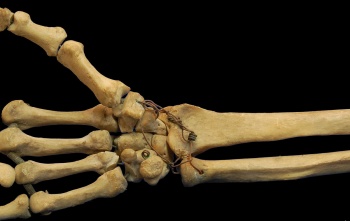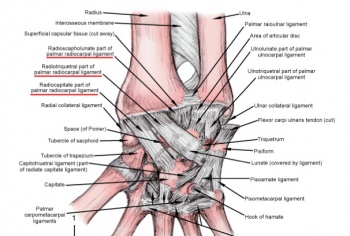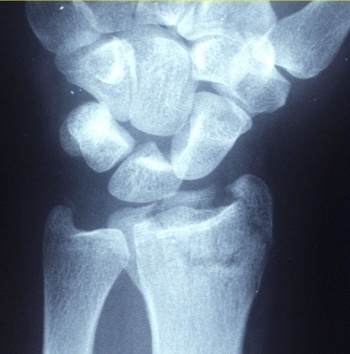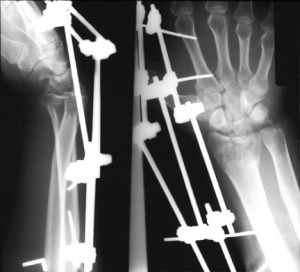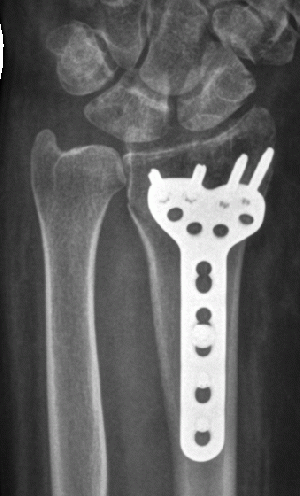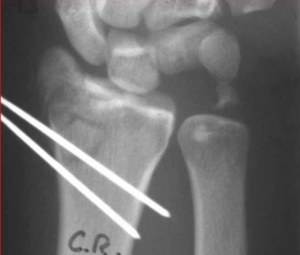Distal Radial Fractures
Original Editors - Diane Hodges Popps
Top Contributors - Laura Ritchie, Diane Hodges Popps, Jocelyn Fu, Kim Jackson, Admin, Katherine Knight, Nupur Smit Shah, Evan Thomas, WikiSysop, Ulrike Lambrix, Jess Bell, Jorge Rodríguez Palomino, Felicia Daigle, Jeremy Brady, Elien Lebuf, Tarina van der Stockt, Karen Wilson, Lauren Lopez and Tony Lowe
Definition/Description[edit | edit source]
The radius is the larger of the two bones of the forearm and is located radially. The distal end of the radius is defined as the area three centimetres proximal to the radiocarpal joint, where the radius interfaces with the lunate and scaphoid bone of the wrist. A fracture of the distal radius is usually caused by falling on the outstretched arm[1]. The majority of distal radial fractures are closed injuries in which the overlying skin remains intact[2][3]. The radius is the most commonly broken bone in the arm.
For centuries, this fracture was classified as a dislocation of the wrist, but this description remains obscure. In 1814, it was redefined by an Irish surgeon and anatomist, Abraham Colles as a fracture and subsequently was given the name, Colles' fracture[4].
Clinically Relevant Anatomy[edit | edit source]
The wrist joint (also known as the radiocarpal joint) is a synovial joint in the upper limb, marking the area of transition between the forearm and the hand.
The wrist joint is formed distally by the proximal row of carpal bones (except the pisiform);
- os scaphoid
- os lunate
- os triquete
The wrist joint is formed proximally by the distal end of the radius and the articular disc.
Multiplanar wrist motion is based on three articulations:
- radioscaphoid
- radiolunate
- distal radioulnar joints
The ulna is not part of the wrist joint – it articulates with the radius in two locations, the superior and the inferior radio-ulnar joint. Eighty percent of axial load is supported by the distal radius and twenty percent by the ulna. A fibrocartilaginous disc, called the articular disc, lies over the superior surface of the ulnar. This disc prevents the ulnar from articulating with the carpal bones. Together, the carpal bones form a convex surface which articulates with the concave surface of the radius and articular disc.
There are several known ligamentous attachments to the distal radius. These often remain intact during distal radius fractures. The volar ligaments are stronger and give more stability to the radiocarpal articulation than the dorsal ligaments[5].
Epidemiology /Aetiology[edit | edit source]
Distal radial fractures are one of the most common fractures of the upper extremity in adults, accounting for a sixth of all fractures in the emergency department. It is seen predominantly in the older caucasian population[2][3][6][7][8]. There is typically a history of a fall or similar trauma to the upper extremity. Pain and swelling in the forearm or wrist are common. Bruising and deformity in the wrist or forearm are also possible[9].
In women, the incidence of distal radial fracture increases with age from 40 years. Before 40 years, the incidence of distal radial fracture is much higher in men. Distal radial fractures in younger adults are usually the result of a high-energy trauma such as a motor vehicle accident, fall from height or athletic participation[10]. In older adults, they are often the result of a low-energy or moderate trauma such as falling from standing height. This may reflect the greater fragility of the bone due to osteoporosis in the older adult[2][11].
Characteristics/Clinical Presentation[edit | edit source]
Distal radial fractures can be classified based on their clinical appearance and typical deformity. Dorsal displacement, dorsal angulation, dorsal comminution and radial shortening may all be used to describe the presentation of the fracture. Classification based on fracture patterns such as intra-articular (articular surfaces disrupted) or extra-articular (articular surface of radius intact) may also be used.[2] [13]
1. Classification of intra-articular fracture
- Type Ι: stable, without comminution
- Type ΙΙ: unstable die-punch, dorsal or volar; ΙΙa: reducible, ΙΙb: irreducible
- Type ΙΙΙ: spike fracture; contuses volar structures
- Type ΙV: split fracture; medial complex fractured with dorsal and volar fragments displaced separately
- Type V: explosion fracture; severe communication with major soft-tissue injury
2. Classification of extra-articular fracture
- Type A: extra-articular
- Type A1: extra-articular ulna, radius intact
- Type A2: extra-articular radius, ulna intact
- Type A3: extra-articular, multi fragmentary radius fracture [14]
Types of Fractures[edit | edit source]
Colles Fracture[edit | edit source]
A colles fracture is typically seen as a result of a fall on an outstretched hand and results in a dorsal extra-articular or intra-articular displacement of the fractured radius:
- Intra-articular fractures are generally seen in the younger age group secondary to higher energy forces
- More than 90% of distal radius fractures are Colles' fractures [14]
Smith's Fracture[edit | edit source]
This is a reverse Colles' with a volar displacement, resulting from a fall on a flexed wrist with forearm fixed in supination [14]
Barton's Fracture[edit | edit source]
This is an intra-articular fracture with subluxation or dislocation of the carpus bone.
Complications are common and diverse. They may be the result of injury or treatment and are associated with poorer outcomes. These can include:[15]
- upper extremity stiffness
- carpal tunnel syndrome or medial nerve involvement
- malunion
- carpal instability
- DRUJ dysfunction
- Dupuytren's disease
- radiocarpal arthritis
- tendon/ligament injuries
- post-traumatic osteoarthritis
- compartment syndrome
- infection (mostly by open fractures)[14][15]
- complex regional pain syndrome[7][16][17][18]
Differential Diagnosis[edit | edit source]
Because the mechanism of injury for a distal radial fracture is usually a high energy traumatic incident, radiographs should be taken to confirm the diagnosis and ensure that the surrounding tissues are still intact. Other injuries causing radial sided pain may include TFCC tear or perforation, Galeazzi fracture (fracture to the distal 2/3 of the radius), scaphoid fracture, or radiocarpal ligament injury.
- Malunion - Distal radius malunion is the most common complication, affecting up to 17% of patients. Physical therapists may assess the effect of malunion to determine if surgery is appropriate by performing a detailed physical exam that includes a preoperative history, location and severity of pain, and functional loss[13][18].
- Compartment Syndrome - This complication affects only 1% of patients. Elevate, observe, and loosen cast immediately if compartment syndrome is suspected[18].
- Complex Regional Pain Syndrome (CRPS) - This complication is observed in 8-35% of patients[18]. CRPS should be suspected when pain, limitations in ROM and swelling are disproportionate to the injury. There may also be changes in skin temperature and sweating. In order to obtain a good functional outcome for this patient population, early recognition and a multidisciplinary treatment approach are essential. This approach should include psychiatric and physical/occupational therapy interventions to address pain and functional limitations.
- Dupuytren’s Disease - Patients develop mild contractures in the palm along the fourth and fifth rays within six months of a distal radial fracture. The severity of the contractures determines the treatment course[18].
- Nerve Pathology – Neuropathy may present acutely or throughout treatment. The median nerve is most common (4%), however 1% of patients have ulnar or radial involvement[7]. Physiotherapists may need to refer the patient to an orthopaedic surgeon[18].
- Acute Carpal Tunnel Syndrome – Physiotherapists must be able to identify acute carpal tunnel syndrome, as delayed treatment is associated with poor outcomes, incomplete recovery or a prolonged functional recovery time[7][18].
- Tendon Complications - Physiotherapists should be prepared to refer patients to surgery in the event of tendon complications secondary to irritation with inflammation or rupture from impingement[18].
- Capsule Contracture - Even after physical therapy treatment, some patients do not regain full forearm rotation due to contracture of the distal radioulnar joint capsule. Dorsal contracture limits pronation, volar contracture limits supination, and both may occur together. A DRUJ capsulectomy may be considered if functional ROM is not regained[16].
Diagnostic Procedures[edit | edit source]
Radiographic parameters are used to check detect anatomical anomalies.
There are many classification systems that describe fractures of the distal radius. Classification systems should follow the following two principles:
- The classification should prescribe the treatment
- The classification should suggest the long-term, functional results of treatment or be correlated with these anticipated results[14]
Outcome Measures[edit | edit source]
A Distal Radius Fracture Complication Checklist and Score Sheet was developed to improve prospective data collection[19]. The checklist includes a classification for all DRF complications, each of which is graded for severity (Mild = 1, Moderate = 2, Severe = 3). A total score is then calculated. The categories of the questionnaire are
- nerve complications
- bone/joint complications
- tendon complications
Self-Report Outcome Measures[edit | edit source]
- Visual Analogue Scale (VAS) to evaluate pain[20]
- The Disability of the Arm, Shoulder and Hand questionnaire (DASH)[20][21]
- The Patient-Rated Wrist Evaluation (PRWE)[20][21]
- The Michigan Hand Outcomes Questionnaire (MHQ) is a hand-specific outcome instrument divided in six scales:
- overall hand function
- activities of daily living
- pain
- work performance
- aesthetics
- patient satisfaction with hand function
Physical Outcome Measures[edit | edit source]
- ROM of the wrist with a goniometer [20]
- Grip Strength is an important outcome measure because it is an important function in daily activities[21], it can be measured with a dynamometer[20]. Hand-held dynamometer or Jamar hydraulic hand dynamometer can be used.
Examination[edit | edit source]
Physical therapists must conduct a thorough physical exam including subjective and objective information.
- Subjective exam includes any information given by the patient such as pain experienced, limitations of ROM of the wrist and activity limitations.[7]
- Objective exam includes assessment of wrist and digit ROM, grip and forearm strength, bony and soft-tissue abnormalities, skin integrity and nerve involvement.[7] Be aware that the contralateral extremity may be an unreliable control.[21]
Health care professionals should evaluate the ligamentous integrity in the presence of persistent pain associated with suspected carpal instability as early as possible in order to avoid poor functional outcomes and prolonged recovery. Specific fracture patterns and high energy injuries are strongly indicative of intercarpal ligament involvement[16].
To confirm the diagnosis, x-rays can identify fracture, displacement as well as the number of bony fragments[1].
Medical Management[edit | edit source]
Non-surgical Treatment[edit | edit source]
When the fracture is in an acceptable position, a plaster cast can be applied until the bone heals. If the fracture is displaced, the fragments are realigned (reduced), after which a splint or cast is applied. The cast will be changed two to three weeks after application as the swelling decreases and then removed six weeks after the reduction, assuming an acceptable level of healing has occurred. After this, physical therapy can start to improve the function of the injured wrist[1].
Surgical Treatment[edit | edit source]
If the displaced of the fracture is large enough that reduction is insufficient to achieve acceptable position of the bones, surgery is required.
Orthopaedic surgeons typically recommend surgical repair of displaced articular fractures of the distal radius for active, healthy people[22]. The sheer variety of reduction and fixation options is clear given the publication of a series of five Cochrane reviews focusing on this topic alone. Methods include: 1) closed reduction and percutaneous pinning, either extra-focal or intra-focal, 2) bridging external fixation with or without supplemental Kirschner-wire fixation, 3) dorsal plating, 4) fragment-specific fixation, 5) open reduction and internal fixation with a volar plate through a classic Henry approach, 6) a combination of these methods[2][3][13][17][18][22][23]. According to Bushnell and Bynum (2007), surgical “complications include oedema, haematoma, stiffness, infection, neurovascular injury, loss of fixation, recurrent malunion, nonunion or delayed union, instability, tendon irritation or ruptures, osteoarthritis, residual ulnar-side pain, median neuropathy, complex regional pain syndrome, and problems with the bone-graft harvest site."[13]
- External Fixation – External fixation is typically a closed, minimally invasive method in which metal pins or screws are driven into the bone via small incisions in the skin. These pins can then be fixed externally by either a plaster cast or secured into an external fixator frame.[2] [3] In comparison to a standard immobilization procedure, external fixation of distal radius fractures reduces redisplacement and yields better anatomical results. However, current evidence for better functional outcomes from external fixation is weak and is also associated with high risk for complications such as pin site infections and radial nerve injuries.
- Internal fixation – Internal fixation involves open surgery where the fractured bone is exposed. Dorsal, volar or T-plates with screws may be used.[13] However, due to the invasive and demanding nature of open surgery, there is an increased risk of infection and soft-tissue damage and therefore this type of fixation is usually reserved for more severe injuries.[17]
- Bone Grafts - Upon reduction of distal radial fractures, bony voids are common and can be reduced by inserting bone grafts or bone graft substitutes. Autogenous bone material obtained from the patient themselves or allogenous bone material obtained from cadaver or live donors can be used as filler for reducing bony voids.[25] However, there is a risk of complications including infection, nerve injury or donor site pain, and there is limited evidence that bone scaffolding may improve anatomical or functional outcomes.[26] Bone grafting is required by most procedures except closing wedge.[13]
- Percutaneous Pinning - Another strategy in reducing and stabilising the fractures is percutaneous pinning, which involves insertion of pins, threads or wires through the skin and into the bone.[13] [23] This procedure is typically less invasive and reduction of the fracture is closed upon which the pins placed in the bone are used to fix the distal radial fragment. Current indications for the best technique of pinning, the extent and duration of immobilisation are uncertain, thus the risk of complications likely outweighs the therapeutic benefits of pinning.
- Closed Reduction - In closed reduction, displaced radial fragments are repositioned using different manoeuvres while the arm is in traction. Different methods include manual reduction in which two people pull in the opposite directions to produce and maintain longitudinal traction and mechanical methods of reduction including the use of “finger traps.” However there is insufficient evidence establishing the effectiveness of different methods of closed reduction used in treating distal radial fractures.[18]
- Arthroscopic-assisted reduction - This technique has many advantages over open reduction. In addition to being less invasive, it allows for direct visualisation and reduction of articular displacement, the opportunity to diagnose and treat associated ligamentous injuries, the removal of articular cartilage debris as well as lavage of the radiocarpal joint. The primary limitations for arthroscopic reduction are due the limited number of surgeons with experience, a longer, more difficult procedure, and the potential for compartment syndrome or acute carpal tunnel syndrome with fluid extravasation.[22]
Physical Therapy Management[edit | edit source]
Current physical therapy management for distal radius fractures covers post-surgical or immobilisation treatment[27]. The treatment of distal radius fractures is controversial and further research is required. There is a great need for versatility in treatment options and there is no gold standard. The best treatment option must be decided in accordance to the type of fracture evaluated from the radiographs after temporary reduction. The choice depends on[1]:
- Nature of fracture
- Age of patient
- Activity level of patient
- Surgeon’s personal preference
Education[edit | edit source]
Use of self-management approaches help in developing positive health behaviours during rehabilitation. Self-management programs can provide benefits in participant knowledge, symptom management, self-efficacy and aspects of health status. These programs are usually given to patients with chronic illnesses[28].
Pain Management[edit | edit source]
Ice, elevation and non-prescription medications for pain relief are typically sufficient for relieving pain for this type of injury[1].
Rehabilitation[edit | edit source]
Kay et al[8] found that a rehabilitation program consisting of physiotherapist-directed advice and exercise provided some additional benefits over no physiotherapy intervention for adults following casting and/or pinning for a distal radius fracture[29]. These benefits were improved pain compared to controls at Week 3 and Week 6, reduced activity limitations compared to controls at Week 3 and greater satisfaction compared to controls. The two groups did not differ in terms of recovery of wrist AROM or grip strength[29].
Michlovitz et al[30] published the findings of a survey of physiotherapists, occupational therapists and certified hand therapists to determine common practices in the rehabilitation of patients with DRFs.
During immobilisation:
Less than 10% of DRF caseloads are referred for therapy during this stage. Priorities during immobilisation include managing oedema and finger stiffness, as well as patient education. Home exercise programs are typically provided, addressing ROM of the shoulder, elbow and fingers. Hot/cold modalities may be applied for pain management. Compressive wraps and retrograde massage may be used for management of oedema. In 50% of cases, resting splints were used for support and protection.[30]
After immobilisation:
Ninety percent of surveyed therapists include hot/cold modalities and ROM exercises at this stage. Eighty percent use compressive wraps with retrograde massage, dexterity exercises, joint mobilisation and soft tissue mobilisation. Almost 90% also used strengthening exercises to improve both strength and function. Static or dynamic splints (or both) can be used to address joint stiffness[30].
Smith et al [31] provided the following summary of post-surgical rehabilitation techniques.
| External Fixation | Dorsal Plating | Volar Fixed-Angle Plating |
|---|---|---|
| 1. Early pain and oedema control | 1. Early oedema control | 1.Oedema control, Immediate AROM of wrist and uninvolved joints |
| 2. Pin site care | 2. Resting static wrist splint | 2.Resting static wrist splint in 30° extension |
| 3.Immediate AROM uninvolved joints, rotation of forearm difficult, wrist AROM not possible | 3. Immediate AROM uninvolved joints. | 3. After bony healing: progress active/active-assisted/passive ROM of wrist; protective static wrist splint only; static progressive splinting rarely indicated |
| 4.Desensitization program for irritated radial sensory nerve or CRPS when indicated | 4. Guarded early wrist AROM | 4. Progress activity and ADLs |
| 5. After fixation hardware removed: active/active-assisted/passive ROM of wrist and forearm; focus on digital flexion, wrist extension, ulnar deviation and supination; static progressive splints when indicated; progress activity and ADLs | 5. After bony healing: active/active-assisted/passive ROM of wrist with emphasis on active wrist flexion; preload and release extensor tendon program; static progressive splints when indicated | |
| 6. Progress activity and ADLs |
| [32] | [33] | [34] |
Recovery[edit | edit source]
Because distal radius fractures are so varied and the treatment options are so broad, recovery is different for each individual. Consultation with the treating surgeon may be required to determine when return to various activities can occur.[1]
During the first two months post-surgery, patients report severe pain during movement and severe disability during activities of daily living as assessed with valid and reliable outcome measures such as the Patient Rated Wrist Evaluation (PRWE) and the Disabilities of the Arm, Shoulder, and Hand Questionnaire (DASH).[35] These self-reported deficits are reflected in decreased ROM and decreased grip strength measurements with strength more correlated with functional ability. Most patients achieve the majority of recovery within the first six months. A small minority of patients will experience persistent pain and disability at one year post-injury regardless of treatment protocol,[7] [35] [36] especially when pushing up from sit to stand and when carrying weight. Patients expressing atypical recovery from distal radial fractures need modified treatment programs with goals toward increasing level of function.
Key Research[edit | edit source]
Handoll et al conducted eight Cochrane Reviews targeting distal radial fractures. There was insufficient data from which to draw conclusions. This may be due to poor study design and the heterogeneity of distal radial fractures themselves.
- Different methods of external fixation for treating distal radial fractures in adults [3]
- External Fixation versus conservative treatment for distal radial fractures in adults [2]
- Internal fixation and comparisons of different fixation methods for treating distal radial fractures in adults [17]
- Closed reduction methods for treating distal radial fractures in adults [18]
- Percutaneous pinning for treating distal radial fractures in adults [23]
- Bone grafts and bone substitutes for treating distal radial fractures in adults [26]
- Conservative interventions for treating distal radial fractures in adults [37]
- Rehabilitation for distal radial fractures in adults [38]
In a randomised control trial, Kay et al[27] were supportive of physical therapy intervention, although limitations in the study abound.[8] While no significant differences in grip strength and wrist extension were found in the experimental group, it is important to note that some of the secondary measures showed significant improvement as compared to the control group. These include benefits in activity, pain and satisfaction.
Clinical Bottom Line[edit | edit source]
Due to the fact that distal radial fractures are one of the most common injuries in orthopaedics, it is important for physical therapists to understand the risk factors and treatment options. Although further research is needed to ascertain proper post surgical management, it is recommended based on current evidence that patients should be routinely referred to a physical therapist for education and an exercise program.
References[edit | edit source]
- ↑ 1.0 1.1 1.2 1.3 1.4 1.5 American Academy of Orthopaedic Surgeons. Distal Radius Fractures [Internet]. Rosemont Illinois: American Academy of Orthopaedic Surgeons; 2013 [cited 2017 Oct 19]. Available from: http://orthoinfo.aaos.org/topic.cfm?topic=a00412 (Level of Evidence = 5)
- ↑ 2.0 2.1 2.2 2.3 2.4 2.5 2.6 Handoll HHG, Huntley JS, Madhok R. External Fixation versus conservative treatment for distal radial fractures in adults (Review). The Cochrane Library. 2008;4:1-78.
- ↑ 3.0 3.1 3.2 3.3 3.4 Handoll HHG, Huntley JS, Madhok R. Different methods of external fixation for treating distal radial fractures in adults (Review). The Cochrane Library. 2008;4:1-67.
- ↑ Benjamin JA. 1965. Abraham Colles (1773–1843) Distinguished surgeon from Ireland. Invest Urol 3:321–323
- ↑ Kenneth J. Koval, Joseph D. Zuckerman, Handbook of fractures, Philadelphia, second edition, 1994, pg 134.
- ↑ Abramo A, Kopylov P, Tagil M. Evaluation of a treatment protocol in distal radius fractures: a prospective study in 581 patients using DASH as outcome. Acta Orthopaedica. 2008;79(3):376-385
- ↑ 7.0 7.1 7.2 7.3 7.4 7.5 7.6 Bienek T, Kusz D, Cielinski L. Peripheral nerve compression neuropathy after fractures of the distal radius. J Hand Surg. (British and European Volume). 2006;31B(3):256-260.
- ↑ 8.0 8.1 8.2 Kay S, McMahon M, Stiller K. An advice and exercise program has some benefits over natural recovery after distal radius fracture: a randomized trial. Aust J Physiother. 2008;54:253-259. (Level of Evidence = 1B)
- ↑ Nelson DL. Wrist Fracture [Internet]. Greenbrae California: David Nelson MD; 2012 [cited 2017 Oct 19]. Available from: http://www.davidlnelson.md/articles/Wrist_Fracture.htm
- ↑ Kenneth J. Koval, Joseph D. Zuckerman, Handbook of fractures, Philadelphia, second edition, 1994, pg 134-135
- ↑ Leung F, Ozkan M, Chow SP. Conservative treatment of intra-articular fractures of the distal radius – factors affecting functional outcomes. Hand Surg. 2000;5(2):145-153.
- ↑ UWTV. Distal Radius Fractures. Available from: http://www.youtube.com/watch?v=uaj0IDd4l0M[last accessed 30/10/17]
- ↑ 13.0 13.1 13.2 13.3 13.4 13.5 13.6 Bushnell BD, Bynum DK. Malunion of the distal radius. J Am Acad Orthop Surg. 2007;15:27-40.
- ↑ 14.0 14.1 14.2 14.3 14.4 Kenneth J. Koval, Joseph D. Zuckerman, Handbook of fractures, Philadelphia, second edition, 1994, pg 135-138
- ↑ 15.0 15.1 Oren T, Wolf J. Soft- Tissue complications associated with distal radius fractures. Operative Techniques in Orthopaedics.19; 2009: 100—106.
- ↑ 16.0 16.1 16.2 Kleinman WB. Distal radius instability and stiffness; common complications of distal radius fractures. Hand Clin. 2010;26:245-264.
- ↑ 17.0 17.1 17.2 17.3 Handoll HHG, Madhok R. Conservative interventions for treating distal radial fractures in adults (Review). The Cochrane Library. 2008;4:1-112.
- ↑ 18.00 18.01 18.02 18.03 18.04 18.05 18.06 18.07 18.08 18.09 18.10 Patel VP, Paksima N. Complications of distal radius fracture fixation. Bulletin of NYU Hospital for Joint Diseases. 2010;68(2):112-8.
- ↑ McKay SD, MacDermid JC, Roth JH, Richards Rs. “Assessment of complications of distal radius fractures and development of a complication checklist.” J. Hand Surg. Am., nr 5; 26, September 2001: 916-22.
- ↑ 20.0 20.1 20.2 20.3 20.4 Walenkamp M., et al. Surgery versus conservative treatment in patients with type A distal radius fractures, a randomised controlled trial. BMC Musculoskeletal disorders 2014, 15:90.
- ↑ 21.0 21.1 21.2 21.3 Leiv M. Hove, Lindau T, Holmer P. Distal radius fractures: current concepts. Berlin, Heidelberg- Springer (2014) pg. 53- 58
- ↑ 22.0 22.1 22.2 Leone J, Bhandari M, Adili A, McKenzie S, Moro JK, Dunlop RB. Predictors of early and late instability following conservative treatment of exta-articular distal radius fractures. Arch Orthop Trauma Surg. 2004;124:38-41.
- ↑ 23.0 23.1 23.2 Herzberg G. Intra-articular fracture of the distal radius: arthroscopic-assisted reduction. J Hand Surg. 2010;35A:1517-1519.
- ↑ flatuber. Distal Radius Fracture 1. Available from: http://www.youtube.com/watch?v=DmXkjliVLuk[last accessed 26/10/17]
- ↑ Handoll HHG, Huntley JS. Bone grafts and bone substitutes for treating distal radial fractures in adults (Review). The Cochrane Library. 2009;3:1-87.
- ↑ 26.0 26.1 Handoll HHG, Watts AC. Internal fixation and comparisons of different fixation methods for treating distal radial fractures in adults (Protocol). The Cochrane Library. 2008;4:1-14.
- ↑ 27.0 27.1 Kay S, McMahon M, Stiller K. An advice and exercise program has some benefits over natural recovery after distal radius fracture: a randomised trial. Australian Journal of Physiotherapy. 2008 Jan 1;54(4):253-9.
- ↑ Bruder A, Taylor N, Dodd K, Shields N. Physiotherapy intervention practice patterns used in rehabilitation after distal radius fracture. Physiotherapy. 2013. 99: 233-240.
- ↑ 29.0 29.1 Kay S, McMahon M, Stiller K. An advice and exercise program has some benefits over natural recovery after distal radius fracture. Australian Journal of Physiotherapy. 2008. 54(4): 253-259.
- ↑ 30.0 30.1 30.2 Michlovitz S., et al. Distal Radius Fractures: Therapy Practice Patterns. J Hand Ther. 2001; 14:4: 249-257.
- ↑ Smith DW, Brou KE, Henry MH. Early active rehabilitation for operatively stabilized distal radius fractures. J Hand Ther. 2004. 17(1): 43-49.
- ↑ physicaltherapyvideo. Broken Wrist Exercises after taking off Cast (Fingers-Physical Therapy. Available from: https://www.youtube.com/watch?v=5POz39-8738 [last accessed 30/10/17]
- ↑ physicaltherapyvideo. Broken Wrist Exercises after taking off cast (wrist & forearm). Available from: https://www.youtube.com/watch?v=hBxpPrTvpBg [last accessed 30/10/17]
- ↑ physicaltherapyvideo. Hand, Wrist, & Forearm Strengthening (Best Exercises-in our Opinion). Available from: https://www.youtube.com/watch?v=R37_inXpZ3g [last accessed 30/10/17]
- ↑ 35.0 35.1 MacDermid JC, Roth JH, Richards RS. Pain and disability reported in the year following a distal radius fracture: A cohort study. BMC Musculoskelet Disord. 2003;4:24-36.
- ↑ Moore CM, Leonardi-Bee J. The prevalence of pain and disability one year post fracture of the distal radius in a UK population: A cross sectional survey. BMC Musculoskeletl Disord. 2008;9:129-138.
- ↑ Handoll HHG, Huntley JS, Madhok R. Closed reduction methods for treating distal radial fractures in adults (Review). The Cochrane Library. 2008;4:1-29.
- ↑ Handoll HHG, Vaghela MV, Madhok R. Percutaneous pinning for treating distal radial fractures in adults (Review). The Cochrane Library. 2008;4:1-70.
